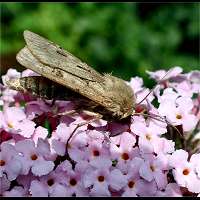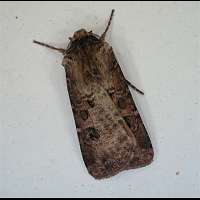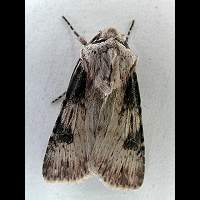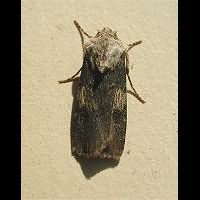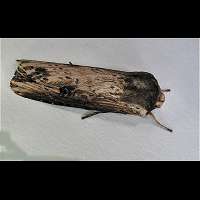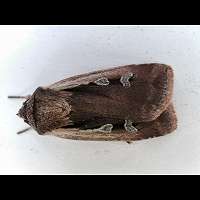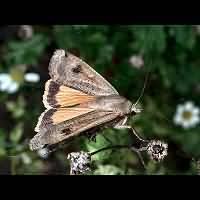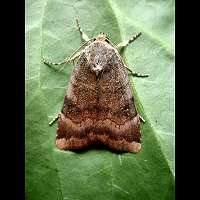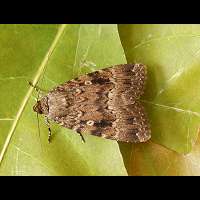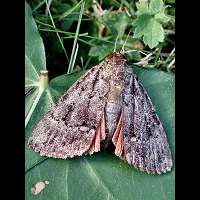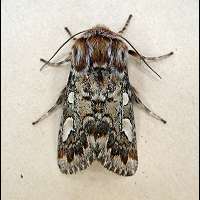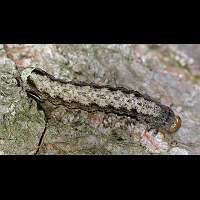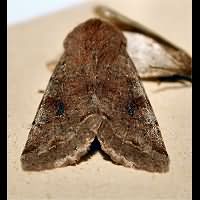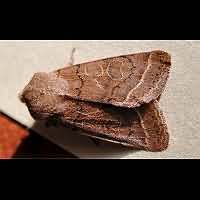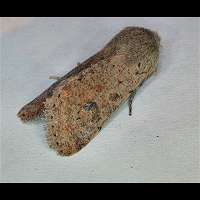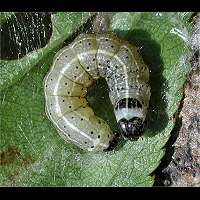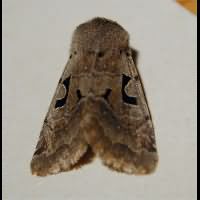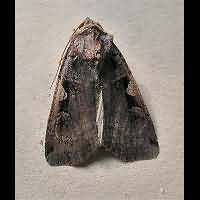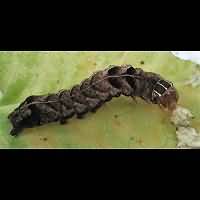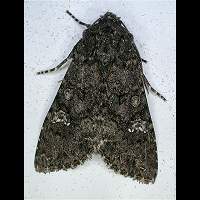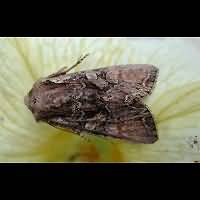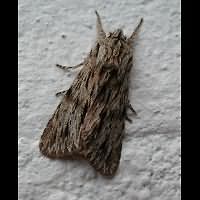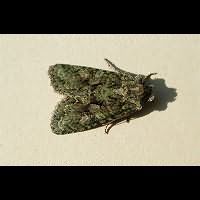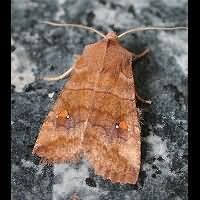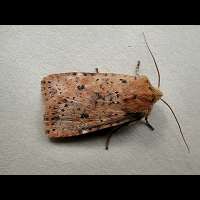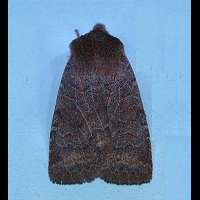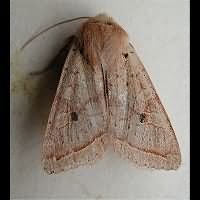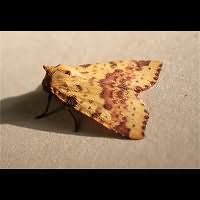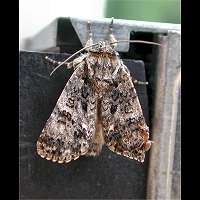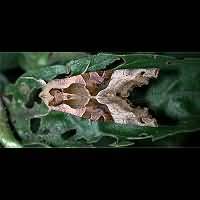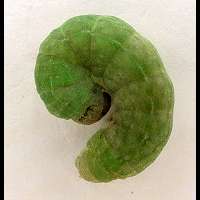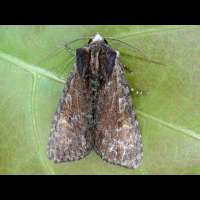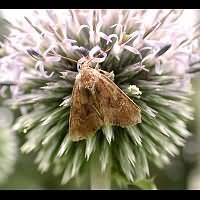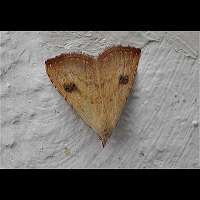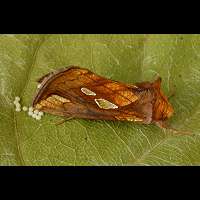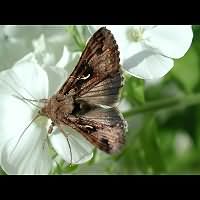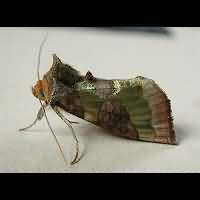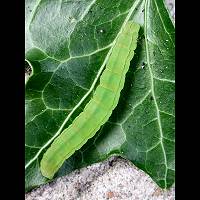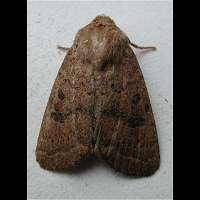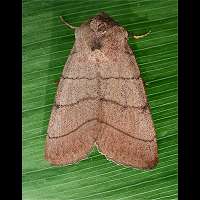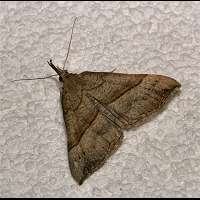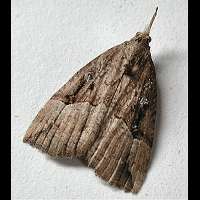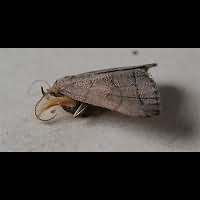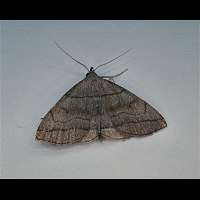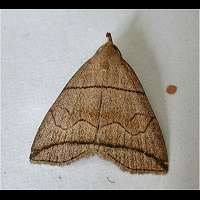[All pictures of garden wildlife on this page are thumbnails. Click on any thumbnail for a large format to be displayed.]
Owlet Moths (Noctuidae)
The Noctuids make up a very big family of moths. There are over 20,000 species known worldwide. In Britain it is the largest Moth family and represented by over 400 species. Most species are robust moths with long usually brownish wings, which have given them the common name of Owlet Moths. The wings are quite narrow, though. Some owlets have a different appearance, such as the Fan-feet and the Snouts. These do look like a crossing between Geometer Moths and Grassmoths. Minors and Rustics are extremely small and are often mistaken for micro moths, especially Pyralids. There are only very few Noctuids active during the day; most fly by night exclusively. But the moth most seen during daytime all over the country is an Owlet Moth: the Silver Y. Some Minors also fly in sunshine. Noctuids are good flyers. Contrary to the Geometer Moths, even though these have much larger wings. Among the Noctuids are quite some migrant species, travelling thousands of miles each year. In order to identify Noctuids two spots on the wings are very important: the bean-shaped kidney spot and the circular spot nearby. By studying these spots carefully it is sometimes possible to tell apart two very similar species. Most Noctuids pupate in or close near the ground in a cocoon. Usually Owlet Moths overwinter being either egg or pupa. Some species overwinter in the larval stage, though. Only very few species overwinter being adult. The Owlet Moths are split up in various subfamilies scientifically. But it is rather confusing, changes often and doesn't mean much to the amateur. So we haven't even tried that on this site.
The Noctuids make up a very big family of moths. There are over 20,000 species known worldwide. In Britain it is the largest Moth family and represented by over 400 species. Most species are robust moths with long usually brownish wings, which have given them the common name of Owlet Moths. The wings are quite narrow, though. Some owlets have a different appearance, such as the Fan-feet and the Snouts. These do look like a crossing between Geometer Moths and Grassmoths. Minors and Rustics are extremely small and are often mistaken for micro moths, especially Pyralids. There are only very few Noctuids active during the day; most fly by night exclusively. But the moth most seen during daytime all over the country is an Owlet Moth: the Silver Y. Some Minors also fly in sunshine. Noctuids are good flyers. Contrary to the Geometer Moths, even though these have much larger wings. Among the Noctuids are quite some migrant species, travelling thousands of miles each year. In order to identify Noctuids two spots on the wings are very important: the bean-shaped kidney spot and the circular spot nearby. By studying these spots carefully it is sometimes possible to tell apart two very similar species. Most Noctuids pupate in or close near the ground in a cocoon. Usually Owlet Moths overwinter being either egg or pupa. Some species overwinter in the larval stage, though. Only very few species overwinter being adult. The Owlet Moths are split up in various subfamilies scientifically. But it is rather confusing, changes often and doesn't mean much to the amateur. So we haven't even tried that on this site.
Heart and Dart Agrotis exclamationis
It doesn't happen every day, but sometimes the Heart and Dart flies in full sunshine. More...
It doesn't happen every day, but sometimes the Heart and Dart flies in full sunshine. More...
Heart and Club Agrotis clavis
The circular spot looks a bit like an eye, which is a good way to identify the Heart and Club. More...
The circular spot looks a bit like an eye, which is a good way to identify the Heart and Club. More...
Flame Axylia putris
The Flame is one of the very few Noctuids curling the wings around the body when at rest. More...
The Flame is one of the very few Noctuids curling the wings around the body when at rest. More...
Flame Shoulder Ochropleura plecta
The Flame Shoulder is regularly found resting in homes, sheds and stables. More...
The Flame Shoulder is regularly found resting in homes, sheds and stables. More...
Large Yellow Underwing Noctua pronuba
The underwings of the Large Yellow Underwing are a great contrast to the upperwings. More...
The underwings of the Large Yellow Underwing are a great contrast to the upperwings. More...
Lesser Broad-bordered Yellow Underwing Noctua janthe
The Lesser Broad-bordered Yellow Underwing proofs that common names are not always better than the scientific ones. More...
The Lesser Broad-bordered Yellow Underwing proofs that common names are not always better than the scientific ones. More...
Svensson's Copper Underwing Amphipyra berbera
Svensson's Copper Underwing can be told apart from the Copper Underwing only by closely inspecting the underwing and body of the animal. More...
Svensson's Copper Underwing can be told apart from the Copper Underwing only by closely inspecting the underwing and body of the animal. More...
Pine Beauty Panolis flammea
The Pine Beauty is available in two varieties: reddish and silvery grey. More...
The Pine Beauty is available in two varieties: reddish and silvery grey. More...
Twin-spotted Quaker Perigrapha munda
The Twin-spotted Quaker has a very well chosen name indeed!. Used to be called Orthosia munda. More...
The Twin-spotted Quaker has a very well chosen name indeed!. Used to be called Orthosia munda. More...
Twin-spotted Quaker Perigrapha munda
The caterpillar of the Twin-spotted Quaker is quite distinctly marked. More...
The caterpillar of the Twin-spotted Quaker is quite distinctly marked. More...
Clouded Drab Orthosia incerta
This big Drab is usually identified by the shape of the wing rather than the markings on it, or the colour. More...
This big Drab is usually identified by the shape of the wing rather than the markings on it, or the colour. More...
Common Quaker Orthosia cerasi
The Common Quaker sometimes is clearly marked like the animal in the picture. Usually it is not. And even the colour is extremely variable. More...
The Common Quaker sometimes is clearly marked like the animal in the picture. Usually it is not. And even the colour is extremely variable. More...
Small Quaker Orthosia cruda
The Small Quaker is a very variable species. Best identified by its small size: the wingspan is 28 to 32mm only. More...
The Small Quaker is a very variable species. Best identified by its small size: the wingspan is 28 to 32mm only. More...
Small Quaker Orthosia cruda
Full grown larvae have a charateristic black dot just behind the head. More...
Full grown larvae have a charateristic black dot just behind the head. More...
Hebrew Character Orthosia gothica
The Hebrew Character is the character on the wing first: it is a spring time species. More...
The Hebrew Character is the character on the wing first: it is a spring time species. More...
Setaceous Hebrew Character Xestia c-nigrum
The Setaceous Hebrew Character is very similar to the Hebrew Character, but flies in summer, not in spring. More...
The Setaceous Hebrew Character is very similar to the Hebrew Character, but flies in summer, not in spring. More...
Double Square Spot Xestia triangulum
The C in the Double Square Spot is broken in the middle, causing two black square spots to show. More...
The C in the Double Square Spot is broken in the middle, causing two black square spots to show. More...
Square-spot Rustic Xestia xanthographa
It is very easy to identify the Square-spot Rustic. Square is an unusual shape in nature. More...
It is very easy to identify the Square-spot Rustic. Square is an unusual shape in nature. More...
Dot Moth Melanchra persicariae
Til now we have only been seeing the caterpillar of the Dot Moth in our garden. More...
Til now we have only been seeing the caterpillar of the Dot Moth in our garden. More...
Cabbage Moth Mamestra brassicae
The caterpillar of the Cabbage Moth is not very welcome, as it eats... cabbage. More...
The caterpillar of the Cabbage Moth is not very welcome, as it eats... cabbage. More...
Pale-shouldered Brocade Lacanobia thalassina
The Pale-shouldered Brocade can be identified by the white W near the edge of the wing and the pale shoulders. More...
The Pale-shouldered Brocade can be identified by the white W near the edge of the wing and the pale shoulders. More...
Sprawler Asteroscopus sphinx
The name Sprawler refers to the interesting caterpillar and not the dull adult. More...
The name Sprawler refers to the interesting caterpillar and not the dull adult. More...
Green-brindled Crescent Allophyes oxyacanthae
The green scales in the Green-brindled Crescent are only revealed in a close up. More...
The green scales in the Green-brindled Crescent are only revealed in a close up. More...
Brindled Green Dryobotodes eremita
The Brindled Green has certain colour accents. In green, of course More...
The Brindled Green has certain colour accents. In green, of course More...
Satellite Eupsilia transversa
The Satellite is named after a sun (the orange dot) and the two moons orbiting it. By the way: the sun may be white or yellow. More...
The Satellite is named after a sun (the orange dot) and the two moons orbiting it. By the way: the sun may be white or yellow. More...
Dotted Chestnut Conistra rubiginea
The Dotted Chestnut may be on the wing in winter and is one of the first moths to announce spring. More...
The Dotted Chestnut may be on the wing in winter and is one of the first moths to announce spring. More...
Chestnut Conistra vaccinii
The Chestnut can be identified only by looking at the shape of the wing. More...
The Chestnut can be identified only by looking at the shape of the wing. More...
Yellow-line Quaker Agrochola macilenta
The Yellow-line Quaker is unmistakable because of its colour and because ii is on the wing in late autumn. More...
The Yellow-line Quaker is unmistakable because of its colour and because ii is on the wing in late autumn. More...
Pink-barred Sallow Xanthia togata
The Pink-barred Sallow is rather like a Geometer Moth, having broad wings and a beautiful colour. More...
The Pink-barred Sallow is rather like a Geometer Moth, having broad wings and a beautiful colour. More...
Knot Grass Acronicta rumicis
The Knot Grass is often quite difficult to identify, for it is highly variable. More...
The Knot Grass is often quite difficult to identify, for it is highly variable. More...
Angle Shades Phlogophora meticulosa
Angle Shades is quite similar to a Hawk-moth and beautifully coloured. More...
Angle Shades is quite similar to a Hawk-moth and beautifully coloured. More...
Angle Shades Phlogophora meticulosa
The caterpillar of the Angle Shades on this page is green. But it may be brown just the same. More...
The caterpillar of the Angle Shades on this page is green. But it may be brown just the same. More...
Dun-bar Cosmia trapezina
The caterpillars of the Dun-bar are the only ones in Britain actually hunting for other caterpillars to eat. More...
The caterpillars of the Dun-bar are the only ones in Britain actually hunting for other caterpillars to eat. More...
Lunar-spotted Pinion Cosmia pyralina
The Lunar-spotted Pinion visits aphids to eat their honeydew. More...
The Lunar-spotted Pinion visits aphids to eat their honeydew. More...
Clouded-bordered Brindle Apamea crenata
There are two versions of the Clouded-bordered Brindle: a lighter one and this dark one. It is not always easy to identify this species. More...
There are two versions of the Clouded-bordered Brindle: a lighter one and this dark one. It is not always easy to identify this species. More...
Common Rustic Mesapamea secalis
The Common Rustic is a very small Noctuid. Because of the size and the fact it regularly flies in sunshine, it is often mistaken for a micro moth belonging to the Pyralid family. More...
The Common Rustic is a very small Noctuid. Because of the size and the fact it regularly flies in sunshine, it is often mistaken for a micro moth belonging to the Pyralid family. More...
Middle-barred Minor Oligia fasciuncula
The Middle-barred Minor is just one of the six Minor species in Britain and a very variable one. Identification is not always easy. More...
The Middle-barred Minor is just one of the six Minor species in Britain and a very variable one. Identification is not always easy. More...
Straw Dot Rivula sericealis
Extremely small Noctuid reaching a wingspan of no more than 25 mm! Always rests head down.More...
Extremely small Noctuid reaching a wingspan of no more than 25 mm! Always rests head down.More...
Large Wainscot Rhizedra lutosa
The Large Wainscot usually is a big, white Noctuid, dusted with black scales. More...
The Large Wainscot usually is a big, white Noctuid, dusted with black scales. More...
Rosy Marbled Elaphria venustula
Because of its size and the way it sits the Rosy Marmbled is often mistaken for a Tortrix Moth. More...
Because of its size and the way it sits the Rosy Marmbled is often mistaken for a Tortrix Moth. More...
Marbled White Spot Protodeltote pygarga
The Marbled White Spot is another unmistakable species. More...
The Marbled White Spot is another unmistakable species. More...
Golden Plusia Polychrysia moneta
The Golden Plusia is still rather common, but numbers are declining. More...
The Golden Plusia is still rather common, but numbers are declining. More...
Silver Y Autographa gamma
The Silver Y is the brownish, nervously moving moth often seen in sunshine visiting flowers among the Peacocks, Whites, Admirals and Small Tortoiseshells. More...
The Silver Y is the brownish, nervously moving moth often seen in sunshine visiting flowers among the Peacocks, Whites, Admirals and Small Tortoiseshells. More...
Burnished Brass Diachrysia chrysitis
The Burnished Brass is an unmistakable and very common species. More...
The Burnished Brass is an unmistakable and very common species. More...
Hoplodrina octogenaria, a Rustic
Not a British species, but the most common Rustic in the Low Countries. More...
Not a British species, but the most common Rustic in the Low Countries. More...
Snout Hypena proboscidalis
Fanfeet and Snouts, like the Snout, differ from other Noctuids considerably. More...
Fanfeet and Snouts, like the Snout, differ from other Noctuids considerably. More...
Fan-foot Zanclognatha tarsipennalis
This picture of the Fan-foot clearly shows why it was given that name. More...
This picture of the Fan-foot clearly shows why it was given that name. More...
Shaded Fan-foot Herminia tarsicrinalis
The Shaded Fan-foot is named after the shadow between the two top lines. More...
The Shaded Fan-foot is named after the shadow between the two top lines. More...
Small Fan-foot Herminia grisealis
The Small Fan-foot is ornated with a thick bow-shaped line. More...
The Small Fan-foot is ornated with a thick bow-shaped line. More...

© Copyright 1998-2024 gardensafari.net (Hania Berdys)

 English / engels
English / engels  Dutch / nederlands
Dutch / nederlands